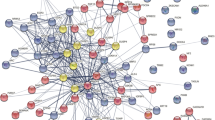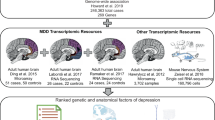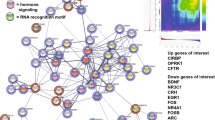ABSTRACT
Herein we report on a large-scale analysis of gene expression in the ‘learned helplessness’ (LH) rat model of human depression, using DNA microarrays. We compared gene expression in the frontal cortex (FC) and hippocampus (HPC) of untreated controls, and LH rats treated with saline (LH-S), imipramine or fluoxetine. A total of 34 and 48 transcripts were differentially expressed in the FC and HPC, respectively, between control and LH-S groups. Unexpectedly, only genes for NADH dehydrogenase and zinc transporter were altered in both the FC and HPC, suggesting limited overlap in the molecular processes from specific areas of the brain. Principal component analysis revealed that sets of upregulated metabolic enzyme genes in the FC and downregulated genes for signal transduction in the HPC can distinguish clearly between depressed and control animals, as well as explain the responsiveness to antidepressants. This comprehensive data could help to unravel the complex genetic predispositions involved in human depression.
This is a preview of subscription content, access via your institution
Access options
Subscribe to this journal
Receive 6 print issues and online access
$259.00 per year
only $43.17 per issue
Buy this article
- Purchase on Springer Link
- Instant access to full article PDF
Prices may be subject to local taxes which are calculated during checkout






Similar content being viewed by others
Abbreviations
- BDNF:
-
brain-derived neurotrophic factor
- EST:
-
expressed sequence tag
- FC:
-
frontal cortex
- HPC:
-
hippocampus
- IS:
-
inescapable shocks
- LH:
-
learned helplessness
- LH-F:
-
LH rats treated with fluoxetine
- LH-I:
-
LH rats treated with imipramine
- LH-S:
-
LH rats treated with saline
- NMDA:
-
N-methyl-D-aspartate
- NREM:
-
nonrapid eye movement
- PKC:
-
protein kinase C
- RT:
-
reverse transcription
- SSRI:
-
selective serotonin reuptake inhibitor
- TCA:
-
tricyclic antidepressant
References
Nestler EJ, Barrot M, DiLeone RJ, Eisch AJ, Gold SJ, Monteggia LM . Neurobiology of depression. Neuron 2002; 34: 13–25.
Fava M, Kendler KS . Major depressive disorder. Neuron 2000; 28: 335–341.
Detera-Wadleigh SD, Badner JA, Berrettini WH, Yoshikawa T, Goldin LR, Turner G et al. A high-density genome scan detects evidence for a bipolar-disorder susceptibility locus on 13q32 and other potential loci on 1q32 and 18p11.2. Proc Natl Acad Sci USA 1999; 96: 5604–5609.
Overmier JB, Seligman ME . Effects of inescapable shock upon subsequent escape and avoidance responding. J Comp Physiol Psychol 1967; 63: 28–33.
Telner JI, Singhal RL . Psychiatric progress. The learned helplessness model of depression. J Psychiatr Res 1984; 18: 207–215.
Geoffroy M, Scheel-Kruger J, Christensen AV . Effect of imipramine in the ‘learned helplessness’ model of depression in rats is not mimicked by combinations of specific reuptake inhibitors and scopolamine. Psychopharmacology 1990; 101: 371–375.
Nankai M, Yamada S, Muneoka K, Toru M . Increased 5-HT2 receptor-mediated behavior 11 days after shock in learned helplessness rats. Eur J Pharmacol 1995; 281: 123–130.
Willner P . A Psychobiological Synthesis. In: Depression. John Wiley & Sons: New York 1985.
Ferguson SM, Brodkin JD, Lloyd GK, Menzaghi F . Antidepressant-like effects of the subtype-selective nicotinic acetylcholine receptor agonist, SIB-1508Y, in the learned helplessness rat model of depression. Psychopharmacology 2000; 152: 295–303.
Sherman AD, Petty F . Learned helplessness decreases [3H]imipramine binding in rat cortex. J Affect Disord 1984; 6: 25–32.
Mac Sweeney CP, Lesourd M, Gandon JM . Antidepressant-like effects of alnespirone (S 20499) in the learned helplessness test in rats. Eur J Pharmacol 1998; 345: 133–137.
Musty RE, Jordan MP, Lenox RH . Criterion for learned helplessness in the rat: a redefinition. Pharmacol Biochem Behav 1990; 36: 739–744.
Drevets WC, Price JL, Simpson Jr JR, Todd RD, Reich T, Vannier M et al. Subgenual prefrontal cortex abnormalities in mood disorders. Nature 1997; 386: 824–827.
Jacobs BL, Praag H, Gage FH . Adult brain neurogenesis and psychiatry: a novel theory of depression. Mol Psychiatry 2000; 5: 262–269.
Malberg JE, Eisch AJ, Nestler EJ, Duman RS . Chronic antidepressant treatment increases neurogenesis in adult rat hippocampus. J Neurosci 2000; 20: 9104–9110.
Eriksson PS, Perfilieva E, Bjork-Eriksson T, Alborn AM, Nordborg C, Peterson DA et al. Neurogenesis in the adult human hippocampus. Nat Med 1998; 4: 1313–1317.
Martin P, Soubrie P, Simon P . The effect of monoamine oxidase inhibitors compared with classical tricyclic antidepressants on learned helplessness paradigm. Progr Neuro-Psychopharmacol Biol Psychiatry 1987; 11: 1–7.
Nakagawa Y, Ishima T, Ishibashi Y, Tsuji M, Takashima T . Involvement of GABAB receptor systems in action of antidepressants. II: Baclofen attenuates the effect of desipramine whereas muscimol has no effect in learned helplessness paradigm in rats. Brain Res 1996; 728: 225–230.
Nakagawa Y, Sasaki A, Takashima T . The GABA(B) receptor antagonist CGP36742 improves learned helplessness in rats. Eur J Pharmacol 1999; 381: 1–7.
Tejedor-Real P, Mico JA, Maldonado R, Roques BP, Gibert-Rahola J . Implication of endogenous opioid system in the learned helplessness model of depression. Pharmacol Biochem Behav 1995; 52: 145–152.
Anthony JP, Sexton TJ, Neumaier JF . Antidepressant-induced regulation of 5-HT(1b) mRNA in rat dorsal raphe nucleus reverses rapidly after drug discontinuation. J Neurosci Res 2000; 61: 82–87.
Bristow LJ, O’Connor D, Watts R, Duxon MS, Hutson PH . Evidence for accelerated desensitisation of 5-HT2C receptors following combined treatment with fluoxetine and the 5-HT1A receptor antagonist, WAY 100,635, in the rat. Neuropharmacology 2000; 39: 1222–1236.
Tordera RM, Monge A, Del Rio J, Lasheras B . Antidepressant-like activity of VN2222, a serotonin reuptake inhibitor with high affinity at 5-HT1A receptors. Eur J Pharmacol 2002; 442: 63–71.
Mirnics K, Middleton AF, Lewis AD, Levitt P . Analysis of complex brain disorders with gene expression microarrays: schizophrenia as a disease of the synapse. Trends Neurosci 2001; 24: 479–486.
Raychaudhuri S, Stuart JM, Altman RB . Principal components analysis to summarize microarray experiments: application to sporulation time series. Pacific Symp Biocomput 2000: 455–466.
Wurmbach E, Yuen T, Ebersole BJ, Sealfon SC . Gonadotropin-releasing hormone receptor-coupled gene network. J Biol Chem 2001; 276: 47195–47201.
Papolos DF, Yu YM, Rosenbaum E, Lachman HM . Modulation of learned helplessness by 5-hydroxytryptamine2A receptor antisense oligodeoxynucleotides. Psychiatr Res 1996; 63: 197–203.
Wu J, Kramer GL, Kram M, Steciuk M, Crawford IL, Petty F . Serotonin and learned helplessness: a regional study of 5-HT1A, 5-HT2A receptors and the serotonin transport site in rat brain. J Psychiatr Res 1999; 33: 17–22.
Pandey GN, Pandey SC, Dwivedi Y, Sharma RP, Janicak PG, Davis JM . Platelet serotonin-2A receptors: a potential biological marker for suicidal behavior. Am J Psychiatry 1995; 152: 850–855.
Velbinger K, De Vry J, Jentzsch K, Eckert A, Henn F, Muller WE . Acute stress induced modifications of calcium signaling in learned helpless rats. Pharmacopsychiatry 2000; 33: 132–137.
Aldenhoff JB, Dumais-Huber C, Fritzsche M, Sulger J, Vollmayr B . Altered Ca(2+)-homeostasis in single T-lymphocytes of depressed patients. J Psychiatr Res 1997; 31: 315–322.
Hayaishi O . Molecular mechanisms of sleep–wake regulation: a role of prostaglandin D2. Philos Trans R Soc London—Ser B Biol Sci 2000; 355: 275–280.
Mizoguchi A, Eguchi N, Kimura K, Kiyohara Y, Qu WM, Huang ZL et al. Dominant localization of prostaglandin D receptors on arachnoid trabecular cells in mouse basal forebrain and their involvement in the regulation of non-rapid eye movement sleep. Proc Natl Acad Sci USA 2001; 98: 11674–11679.
Feng J, Cai X, Zhao J, Yan Z . Serotonin receptors modulate GABA(A) receptor channels through activation of anchored protein kinase C in prefrontal cortical neurons. J Neurosci 2001; 21: 6502–6511.
Missler M, Hammer RE, Sudhof TC . Neurexophilin binding to alpha-neurexins. A single LNS domain functions as an independently folding ligand-binding unit. J Biol Chem 1998; 273: 34716–34723.
Missler M, Sudhof TC . Neurexophilins form a conserved family of neuropeptide-like glycoproteins. J Neurosci 1998; 18: 3630–3638.
Nunoue K, Ohashi K, Okano I, Mizuno K . LIMK-1 and LIMK-2, two members of a LIM motif-containing protein kinase family. Oncogene 1995; 11: 701–710.
Sarmiere PD, Bamburg JR, Meng Y, Zhang Y, Tregoubov V, Janus C et al. Head, neck, and spines. A role for LIMK-1 in the hippocampus. Abnormal spine morphology and enhanced LTP in LIMK-1 knockout mice. Neuron 2002; 35: 3–5.
Steffens DC, Krishnan KR . Structural neuroimaging and mood disorders: recent findings, implications for classification, and future directions. Biol Psychiatry 1998; 43: 705–712.
Okano I, Hiraoka J, Otera H, Nunoue K, Ohashi K, Iwashita S et al. Identification and characterization of a novel family of serine/threonine kinases containing two N-terminal LIM motifs. J Biol Chem 1995; 270: 31321–31330.
Altar CA . Neurotrophins and depression. Trends Pharmacol Sci 1999; 20: 59–61.
Skolnick P . Antidepressants for the new millennium. Eur J Pharmacol 1999; 375: 31–40.
Brandoli C, Sanna A, De Bernardi MA, Follesa P, Brooker G, Mocchetti I . Brain-derived neurotrophic factor and basic fibroblast growth factor downregulate NMDA receptor function in cerebellar granule cells. J Neurosci 1998; 18: 7953–7961.
Gould E, Tanapat P . Stress and hippocampal neurogenesis. Biol Psychiatry 1999; 46: 1472–1479.
McEwen BS . Stress and hippocampal plasticity. Annu Rev Neurosci 1999; 22: 105–122.
McEwen BS . Effects of adverse experiences for brain structure and function. Biol Psychiatry 2000; 48: 721–731.
Prince JA, Blennow K, Gottfries CG, Karlsson I, Oreland L . Mitochondrial function is differentially altered in the basal ganglia of chronic schizophrenics. Neuropsychopharmacology 1999; 21: 372–379.
Maurer I, Zierz S, Moller H . Evidence for a mitochondrial oxidative phosphorylation defect in brains from patients with schizophrenia. Schizophr Res 2001; 48: 125–136.
Jha N, Jurma O, Lalli G, Liu Y, Pettus EH, Greenamyre JT et al. Glutathione depletion in PC12 results in selective inhibition of mitochondrial complex I activity. Implications for Parkinson's disease. J Biol Chem 2000; 275: 26096–26101.
Chinopoulos C, Adam-Vizi V . Mitochondria deficient in complex I activity are depolarized by hydrogen peroxide in nerve terminals: relevance to Parkinson's disease. J Neurochem 2001; 76: 302–306.
Volz HP, Rzanny R, Riehemann S, May S, Hegewald H, Preussler B et al. 31P magnetic resonance spectroscopy in the frontal lobe of major depressed patients. Eur Arch Psychiatr Clin Neurosci 1998; 248: 289–295.
Jaksch M, Lochmuller H, Schmitt F, Volpel B, Obermaier-Kusser B, Horvath R . A mutation in mt tRNALeu(UUR) causing a neuropsychiatric syndrome with depression and cataract. Neurology 2001; 57: 1930–1931.
Kato T . The other, forgotten genome: mitochondrial DNA and mental disorders. Mol Psychiatry 2001; 6: 625–633.
Yoshikawa T, Kikuchi M, Saito K, Watanabe A, Yamada K, Shibuya H et al. Evidence for association of the myo-inositol monophosphatase 2 (IMPA2) gene with schizophrenia in Japanese samples. Mol Psychiatry 2001; 6: 202–210.
Schwab SG, Hallmayer J, Lerer B, Albus M, Borrmann M, Honig S et al. Support for a chromosome 18p locus conferring susceptibility to functional psychoses in families with schizophrenia, by association and linkage analysis. Am J Hum Genet 1998; 63: 1139–1152.
Kroczka B, Branski P, Palucha A, Pilc A, Nowak G . Antidepressant-like properties of zinc in rodent forced swim test. Brain Res Bull 2001; 55: 297–300.
Maes M, Vandoolaeghe E, Neels H, Demedts P, Wauters A, Meltzer HY et al. Lower serum zinc in major depression is a sensitive marker of treatment resistance and of the immune/inflammatory response in that illness. Biol Psychiatry 1997; 42: 349–358.
Quackenbush J . Computational analysis of microarray data. Nat Rev Genet 2001; 2: 418–427.
Steingard RJ, Renshaw PF, Hennen J, Lenox M, Cintron CB, Yuoung AD et al. Smaller frontal lobe white matter volumes in depressed adolescents. Biol Psychiatry 2002; 52: 413–417.
Cowan WM, Kopnisky KL, Hyman SE . The human genome project and its impact on psychiatry. Annu Rev Neurosci 2002; 25: 1–50.
Skolnick P, Legutko B, Li X, Bymaster FP . Current perspectives on the development of non-biogenic amine-based antidepressants. Pharmacol Res 2001; 43: 411–423.
Crescenzi M, Giuliani A . The main biological determinants of tumor line taxonomy elucidated by a principal component analysis of microarray data. FEBS Lett 2001; 507: 114–118.
Landgrebe J, Welzl G, Metz T, van Gaalen MM, Ropers H, Wurst W et al. Molecular characterization of antidepressant effects in the mouse brain using gene expression profiling. J Psychiatr Res 2002; 36: 119–129.
Acknowledgements
We would like to thank Shuichi Tsutsumi and Hiroko Meguro for assistance with microarray data analysis, Yuichi Ishitsuka, Yuki Iijima and Shin-ichi Ohno for help with animal experiments, Kazuo Yamada for useful comments and Joanne Meerabux for critical reading of this manuscript. This study was partly supported by Grants-in-Aid for Young Scientists (B) (No. 13770566) from the Ministry of Education, Culture, Sports and Technology (MEXT).
Author information
Authors and Affiliations
Corresponding author
Additional information
DUALITY OF INTEREST
None declared
Supplementary Information accompanies the paper on The Pharmacogenomics Journal website (http://www.nature.com/tpj).
Supplementary information
Rights and permissions
About this article
Cite this article
Nakatani, N., Aburatani, H., Nishimura, K. et al. Comprehensive expression analysis of a rat depression model. Pharmacogenomics J 4, 114–126 (2004). https://doi.org/10.1038/sj.tpj.6500234
Received:
Revised:
Accepted:
Published:
Issue Date:
DOI: https://doi.org/10.1038/sj.tpj.6500234
Keywords
This article is cited by
-
Differential and Converging Molecular Mechanisms of Antidepressants’ Action in the Hippocampal Dentate Gyrus
Neuropsychopharmacology (2015)
-
Zinc Signaling in the Hippocampus and Its Relation to Pathogenesis of Depression
Molecular Neurobiology (2011)
-
cDNA Microarray Analysis of Gene Expression in the Cerebral Cortex and Hippocampus of BALB/c Mice Subjected to Chronic Mild Stress
Cellular and Molecular Neurobiology (2010)
-
Profiling of behavioral changes and hippocampal gene expression in mice chronically treated with the SSRI paroxetine
Psychopharmacology (2008)
-
Old principles in new clothes
The Pharmacogenomics Journal (2004)



